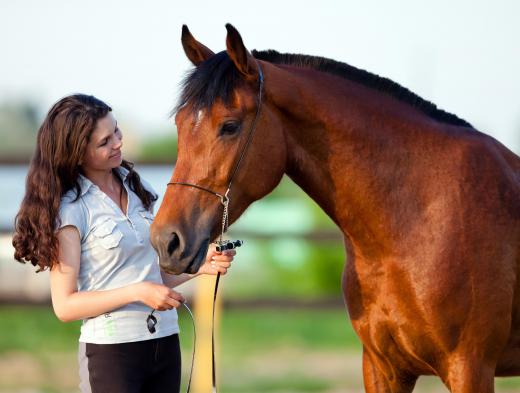In addition to a saddle, a bridle is a fundamental part of the tack used to control a horse. A bridle is worn on the head of a horse, and consists of a headstall attached to a bit and reins. The headstall keeps the bit in place in the mouth, while the reins are used to guide the horse by the rider. There are numerous types of bridles and bits available, including bitless bridles, which use pressure around the nose area to control the horse. The most common type of bit is the snaffle bit, which controls the horse through direct pressure on his or her mouth, rather than more severe bits such as a curb bit, which uses leverage to control the horse, and can be quite hard on the mouth in the hands of an inexperienced rider.
The headstall is the foundation of the bridle, as it keeps the whole assembly in place. Starting at the ears of the horse, a headstall has a crown piece, which goes behind the ears over the head and attaches to a throatlatch, which is fastened to keep the bridle from sliding over the horse's head. Most bridles also have a brow band, which connects to the crown piece and goes in front of the ears. This helps reduce slippage and movement of the bridle. Cheek pieces connect to the throatlatch, and run down the face to the bit. A nose band helps to keep the bridle in place over the nose of the horse.

Horses are always secured when riders tack them up, typically with a halter, a plain headstall with no bit, attached to a line which is used to tie the horse. To put a bridle on, riders start by placing the bit in the mouth and bringing the crown piece up over the head. If the horse has worn the bridle before, the nose band will already be set for comfort, and the rider needs only to fasten the throatlatch. The throatlatch is not set very tightly, as the bridle should not interfere with the ability of the horse to breathe. The cheek pieces and nose band are also adjusted as needed, to make sure that the bridle fits the horse comfortably, and the halter can be removed or left on for riding.

Variants on the bridle design include bridles designed for endurance riding, Western riding, and bridles which can accommodate two bits, used in certain disciplines of horsemanship. Some riders also use a bitless bridle, to start young horses, work gently with older horses, or because they prefer to control their horses with subtle pressure. Both bits and bitless bridles can be cruel if riders do not understand their use, so careful training should always be undertaken. It is also important that a horse never be tied or secured with a bit, as a horse could pull at the bridle, damaging the mouth or potentially choking on a tight throatlatch.
